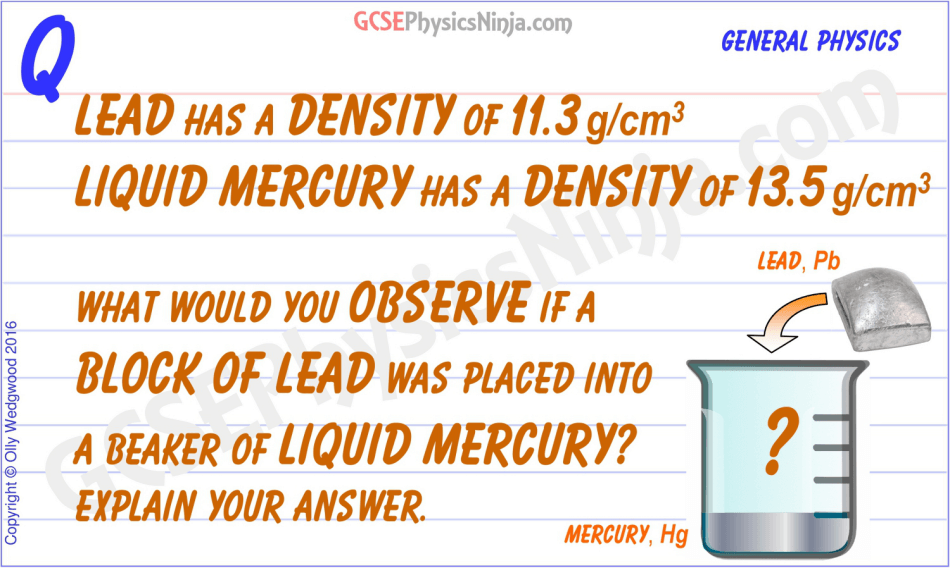Lead has a density of 11.34 grams per cubic centimeter. This makes it one of the densest common metals.
Lead is a heavy, malleable metal with a bluish-gray hue. Its high density makes it useful in various applications, from radiation shielding to batteries. People have used lead for centuries due to its versatile properties. Despite its benefits, lead poses significant health risks if not handled properly.
For this reason, understanding its characteristics is crucial. Lead’s density contributes to its effectiveness in blocking harmful radiation. The metal also finds applications in construction, plumbing, and even in some types of glass. Its unique properties ensure its continued use across different industries. Always take precautions when working with lead to avoid exposure.

Credit: gcsephysicsninja.com
Introduction To Lead
Lead is a dense, soft, and malleable metal. It is bluish-grey in color and is known for its high density. Lead has a density of 11.34 grams per cubic centimeter. This makes it one of the heaviest common metals. People have used lead for thousands of years. It has a wide range of applications due to its unique properties.
Historical Uses
Lead has been used since ancient times. The Romans used lead to make pipes and aqueducts. They also used it in paints, cosmetics, and even in their cooking pots. Lead was important in construction and plumbing. In the 19th century, lead was used in the printing industry. Lead type was used to print newspapers and books. Historical artifacts made of lead are still found today.
Modern Applications
Today, lead is used in many industries. One of the most common uses is in batteries. Lead-acid batteries are used in cars and other vehicles. Lead is also used in radiation shielding. It protects people from harmful X-rays and gamma rays. Lead is used in the construction industry as well. It is found in roofing materials, pipes, and paints. Lead is also used in the production of glass and ceramics. It helps to improve the quality and durability of these materials.
| Application | Industry |
|---|---|
| Batteries | Automotive |
| Radiation Shielding | Medical |
| Construction Materials | Construction |
| Glass and Ceramics | Manufacturing |
Lead remains a valuable material in modern times. Its density and versatility make it essential in many fields.
Physical Properties
Lead is a fascinating metal with unique physical properties. It is known for its high density and low melting point. These properties make it useful in many industries. Let’s explore some of these properties in detail.
Density
Density refers to how much mass is packed into a given volume. Lead has a very high density. Its density is about 11.34 grams per cubic centimeter (g/cm³). This makes lead one of the heaviest common metals. Because of this, lead is often used in weights and radiation shielding.
Melting And Boiling Points
Lead melts at a relatively low temperature compared to other metals. The melting point of lead is 327.5 degrees Celsius (621.5 degrees Fahrenheit). This low melting point makes it easy to cast and mold.
The boiling point of lead is much higher. It boils at 1,749 degrees Celsius (3,180 degrees Fahrenheit). This high boiling point ensures that lead remains solid in most everyday conditions.
Chemical Characteristics
Lead is a heavy metal known for its high density. This makes it valuable in many applications. Let’s explore its chemical characteristics, focusing on reactivity and compounds.
Reactivity
Lead is relatively unreactive compared to other metals. In air, it forms a protective layer of lead oxide. This layer prevents further corrosion. Lead does not react quickly with water. However, it reacts slowly with acids, forming lead salts.
Compounds And Alloys
Lead forms many compounds. Some common ones include:
- Lead(II) oxide (PbO): Used in batteries and glass.
- Lead(IV) oxide (PbO2): Used in lead-acid batteries.
- Lead nitrate (Pb(NO3)2): Used in dyes and explosives.
Lead is also used in various alloys. Some important lead alloys are:
| Alloy | Components | Applications |
|---|---|---|
| Solder | Lead and tin | Joining metal parts |
| Terne | Lead and tin | Coating steel sheets |
| Type metal | Lead, antimony, and tin | Printing press type |
Understanding lead’s chemical characteristics helps in using it safely and effectively.

Credit: www.reddit.com
Health And Environmental Impact
Understanding the density of lead is essential due to its significant health and environmental impact. Lead is dense, and its properties make it useful in many industries. But exposure to lead can be harmful. This section explores how lead’s density influences health and the environment.
Toxicity
Lead is highly toxic. Exposure can cause severe health issues. Ingesting or inhaling lead particles can result in poisoning. Symptoms include abdominal pain, headaches, and memory problems.
Children are particularly vulnerable. Lead exposure can affect their development. It can lead to learning difficulties and behavioral problems.
Adults are also at risk. High levels of lead can damage organs. It can affect the brain, kidneys, and nervous system.
To minimize risk, it’s crucial to limit exposure. Regular testing for lead in environments is necessary. This helps ensure safety.
Environmental Regulations
Various regulations aim to control lead exposure. These rules help protect both health and the environment. Environmental agencies set limits on lead levels in air, water, and soil.
The Environmental Protection Agency (EPA) has strict guidelines. They regulate lead in drinking water. The Occupational Safety and Health Administration (OSHA) sets limits for workplace exposure.
Here is a table showing key regulations:
| Agency | Regulation |
|---|---|
| EPA | Lead and Copper Rule |
| OSHA | Permissible Exposure Limits |
| CDC | Blood Lead Levels |
Following these regulations is crucial. It helps reduce lead contamination. Compliance ensures safer environments for all.
Communities can also play a role. They can advocate for cleaner policies. Raising awareness about lead dangers is essential.
In summary, lead’s density has far-reaching implications. It influences both health and environmental standards. Awareness and regulation are key to managing its impact.
Innovative Uses
Lead’s high density makes it useful in various innovative applications. Its unique properties allow it to serve diverse roles in technology, industry, and scientific research.
Technology And Industry
Lead plays a vital role in the tech and industrial sectors. Its ability to block radiation makes it perfect for shielding. Many factories use lead for this purpose.
Lead is also essential in manufacturing batteries. Lead-acid batteries power cars and backup systems. These batteries are reliable and cost-effective.
Additionally, lead is used in cable sheathing. This protects against moisture and corrosion, ensuring durability.
Here is a table summarizing lead’s uses in technology and industry:
| Use | Description |
|---|---|
| Radiation Shielding | Blocks harmful radiation in medical and industrial settings. |
| Batteries | Used in lead-acid batteries for vehicles and backup systems. |
| Cable Sheathing | Protects cables from moisture and corrosion. |
Scientific Research
Lead’s high density also benefits scientific research. It is used in particle physics experiments. Scientists use lead to contain and study particles safely.
Lead’s stability is another advantage. It is often used in calibration processes. This ensures accurate measurements in experiments.
Lead is also used to shield sensitive equipment from interference. This is crucial in precise scientific measurements.
Here are some notable scientific uses of lead:
- Particle Physics: Containing and studying particles safely.
- Calibration: Ensuring accurate measurements.
- Equipment Shielding: Protecting sensitive instruments from interference.

Credit: www.researchgate.net
Frequently Asked Questions
What Is The Density Of Lead?
Lead has a density of approximately 11. 34 grams per cubic centimeter.
How Does Lead’s Density Compare To Other Metals?
Lead is denser than most common metals, including iron and aluminum.
Why Is Lead So Dense?
Lead’s high density is due to its atomic structure and heavy atomic mass.
Where Is Dense Lead Commonly Used?
Lead is used in batteries, radiation shielding, and weights.
Is Lead The Densest Metal?
No, osmium and iridium are denser than lead.
How Does Lead’s Density Affect Its Properties?
High density makes lead heavy, soft, and malleable, suitable for various industrial applications.
Conclusion
Lead is extremely dense, making it useful in many industries. Its high density provides excellent shielding against radiation. Understanding lead’s properties helps in applications ranging from construction to medical fields. Always consider lead’s density when selecting materials for specific purposes.
Keep exploring material properties to make informed choices in your projects.
